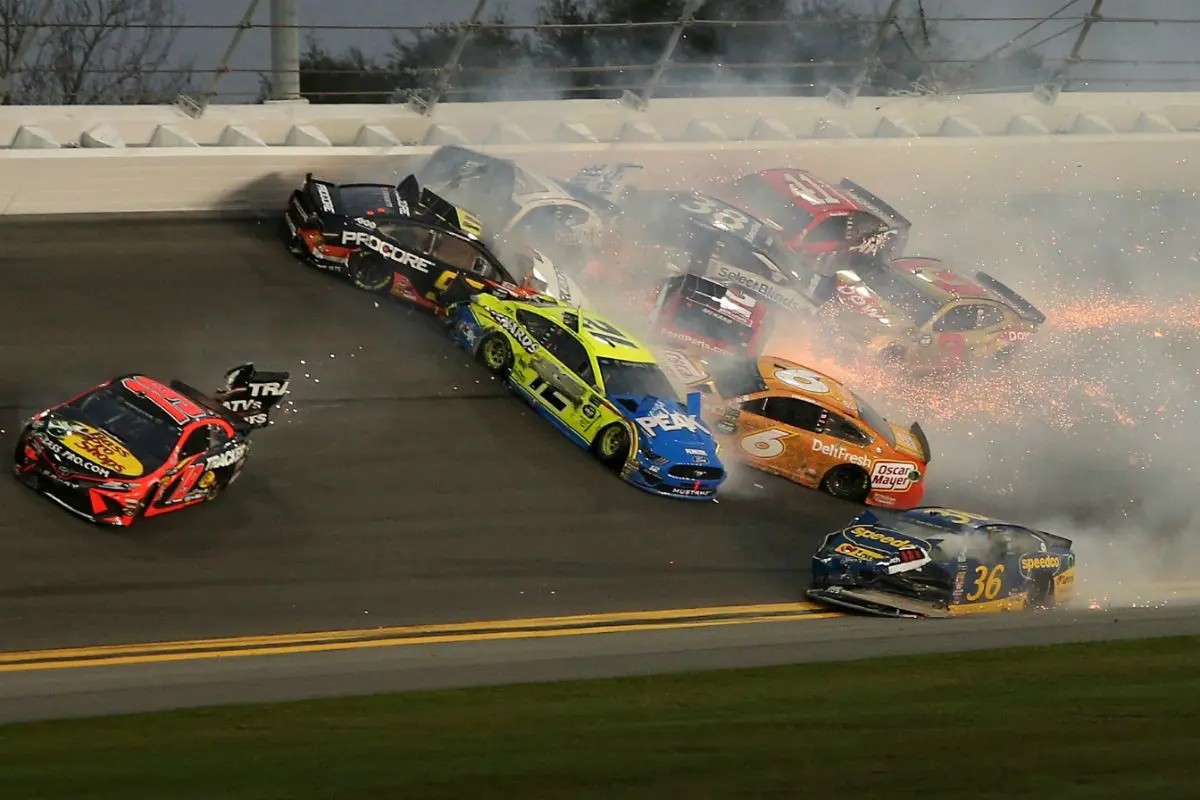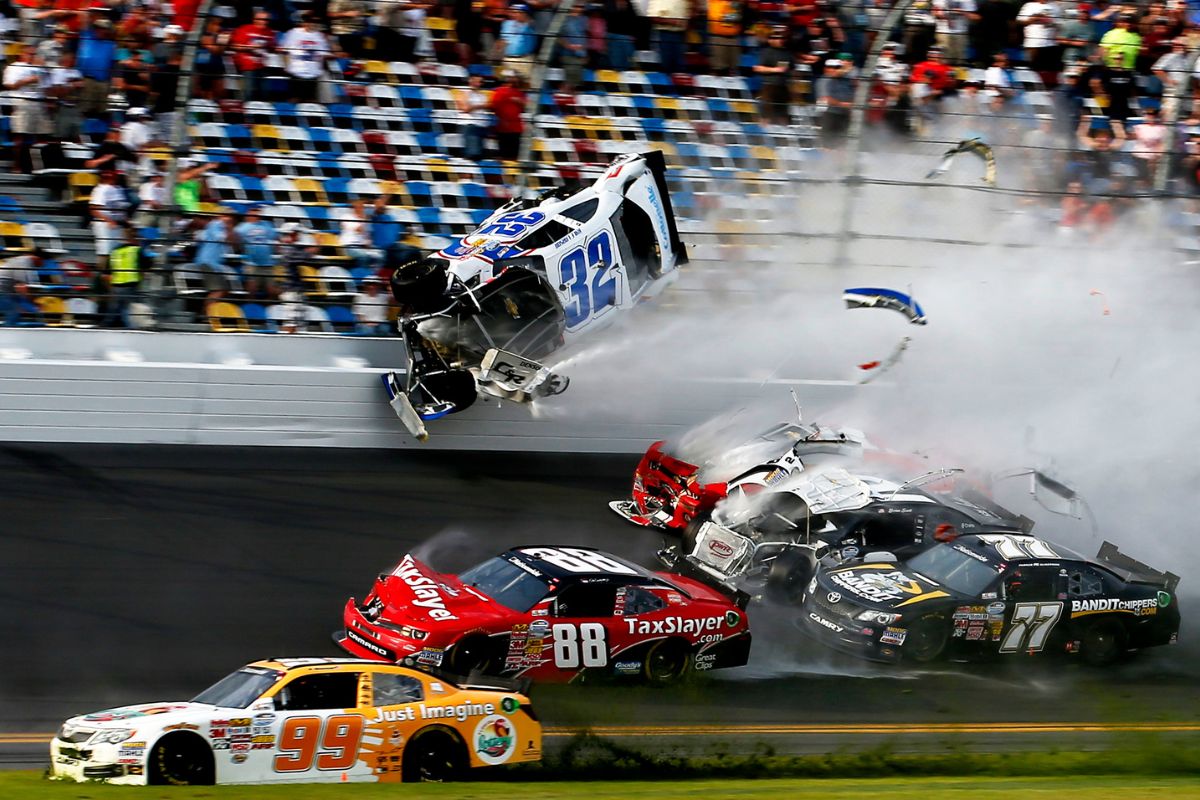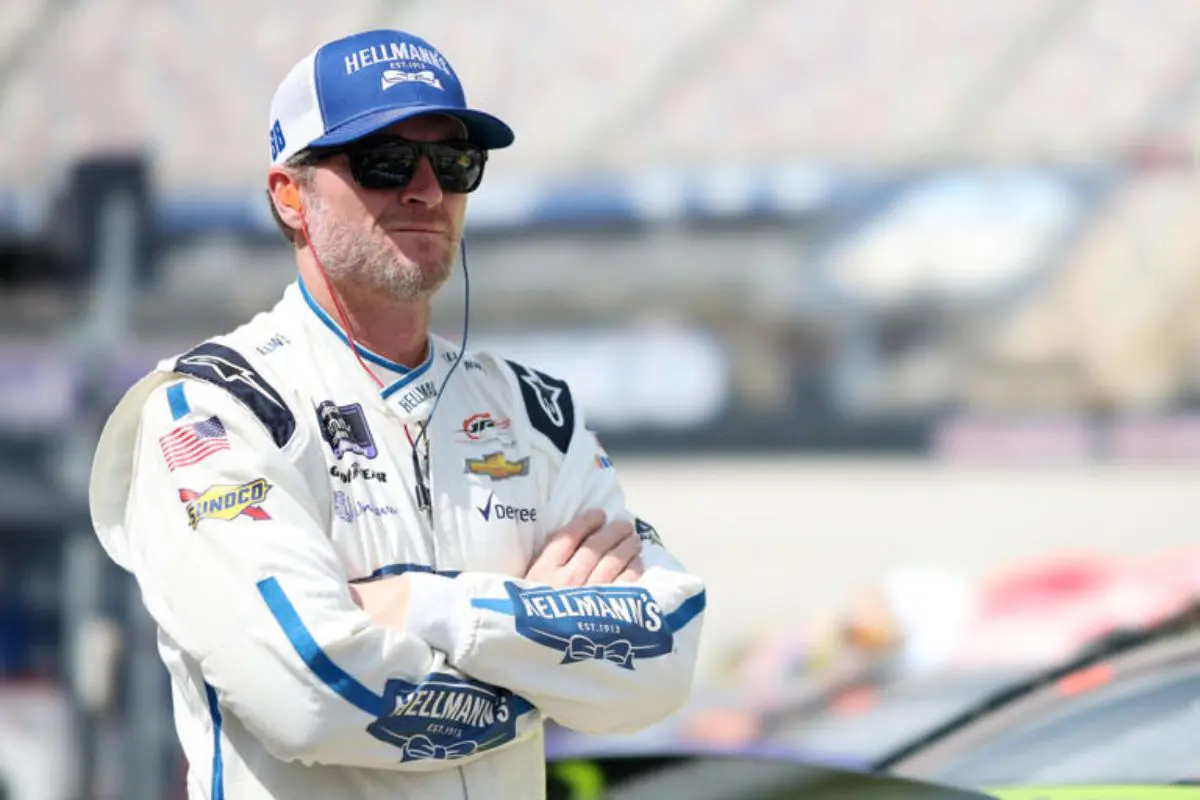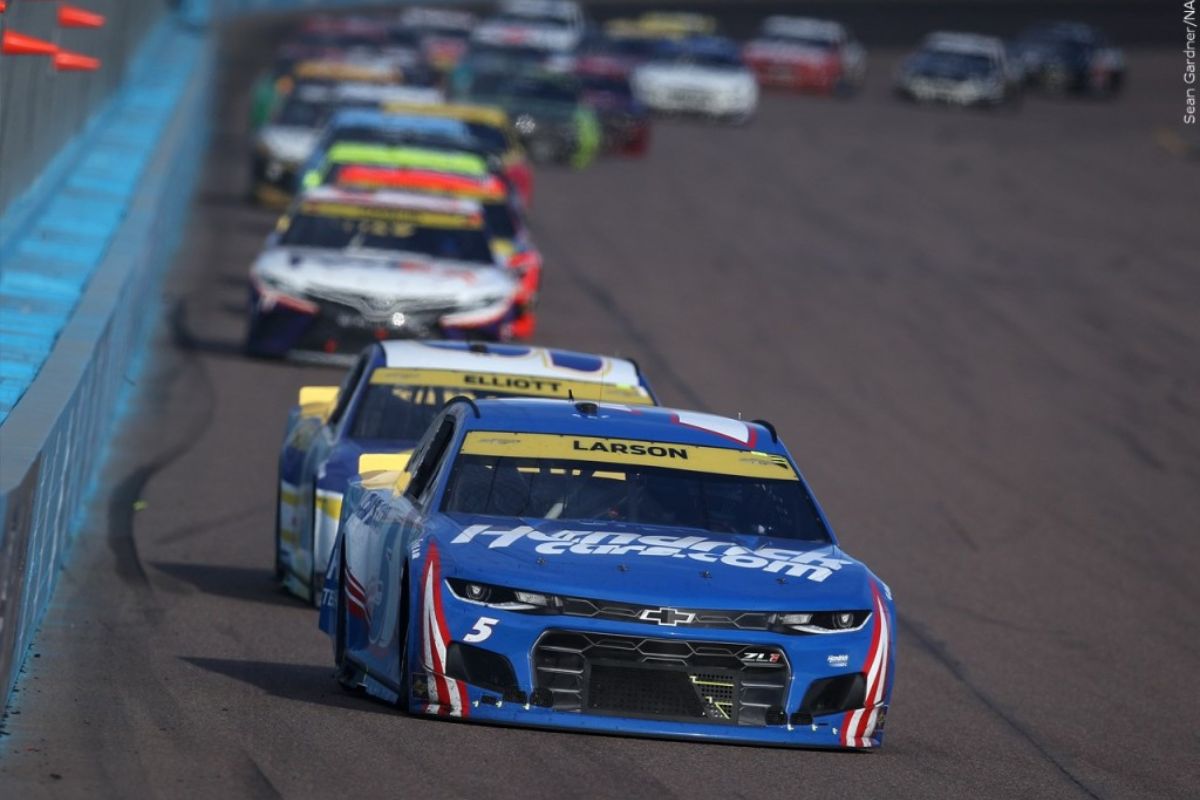Insider Uncovers NASCAR’s Shark-Fin Failure: Recent findings regarding NASCAR’s ‘shark fin’ air deflector have brought to light substantial concerns about its structural integrity and effectiveness in preventing vehicle flips during high-speed races. Despite its intended purpose, a series of incidents has prompted experts, including notable figures such as Todd Gordon, to question the safety measures in place for both drivers and fans. As reactions from prominent racers like Dale Earnhardt Jr. and Bubba Wallace begin to surface, the implications of these revelations could reshape the future of safety protocols in motorsport. What might this mean for the sport’s evolving landscape?
Key Highlights
- Recent flipping incidents, including Corey LaJoie’s, raise concerns about the effectiveness of the shark fin air deflector in preventing airborne crashes.
- The shark fin design may contribute to increased flipping risks, necessitating a reevaluation of NASCAR’s current safety protocols.
- Fan safety is jeopardized by the potential for flipping cars to breach spectator areas, reminiscent of the 2015 Austin Dillon incident.
- Continuous engineering assessments and testing of car designs are critical to enhance structural integrity and reduce flipping incidents.
- Stakeholder engagement is essential to develop comprehensive safety measures that protect both drivers and fans during races.
Overview of the Recent Flipping Incidents
In view of recent developments, the issue of flipping incidents in NASCAR has garnered considerable attention. The driving force behind this examination stems from a series of alarming crashes, particularly highlighted by Corey LaJoie’s unexpected flip at Michigan International Speedway. This incident prompted NASCAR to take immediate action, resulting in the introduction of a new safety feature: an air deflector designed to resemble a shark fin, aimed at mitigating the risk of cars becoming airborne.
However, the effectiveness of this modification has come into question following Josh Berry’s similar flipping incident at Daytona, which mirrored the circumstances surrounding LaJoie’s crash. These incidents raise critical concerns regarding the Next-Gen car’s design and safety protocols.
The implementation of the shark fin was a response to a pressing need for improved aerodynamics and stability, yet the recurrence of flipping incidents suggests that the solution may not have been as effective as intended. The potential for cars to flip not only poses considerable risks to drivers but also threatens the safety of fans and personnel in the vicinity of the racetrack.
As NASCAR continues to navigate the challenges posed by these incidents, it becomes imperative to evaluate both the engineering decisions underpinning the Next-Gen car and the broader safety measures in place. The sport must prioritize innovation while ensuring that such advancements do not compromise the safety of its participants and spectators.
Safety Concerns Raised by Todd Gordon
Amid growing concerns surrounding the safety of NASCAR’s Next-Gen cars, Todd Gordon has voiced considerable apprehensions regarding the recent trend of flipping incidents on the racetrack. The potential risks to both drivers and fans have escalated, prompting a critical evaluation of current safety measures.
Gordon highlights several key issues associated with this phenomenon:
- Increased Flipping Incidents: The frequency of cars flipping has risen, raising alarms about the structural integrity of the vehicles.
- Fan Safety at Stake: The danger extends beyond the drivers; flipping cars pose a notable threat to spectators should they breach the catch fence, as illustrated in the 2015 Austin Dillon incident.
- Design Flaws: Gordon asserts that the modern car design must prioritize stability to prevent unintended airborne events that could jeopardize fan safety.
- Energy Dissipation: While he acknowledges that some crashes, like that of Michael McDowell, may not invoke the same fears, the potential for catastrophic flipping remains a pressing concern.
🗣️ "I would be dumbfounded if we didn't have something different going to Atlanta."
🏎️ Late Shift's @ToddBGordon gave his thoughts on the recent flips with Gen 7 cars and how everyone is working to keep them on the ground.
More → https://t.co/QcAxDUTnOt pic.twitter.com/kGCJA5Yujl
— SiriusXM NASCAR Radio (Ch. 90) (@SiriusXMNASCAR) August 28, 2024
Gordon’s remarks underline a fundamental necessity for ongoing evaluation and improvement of safety protocols.
“We don’t need the cars getting up into the fences and start to jeopardize the safety of our fanbase. So in that respect, we have to have a platform that wants to stay on the ground. I don’t have a problem with the car rolling. But I don’t think cars that lift off on their own because I worry about that happening in a place that puts our fans in jeopardy,”-(Gordon )
His insights advocate for a design philosophy that highlights keeping race cars grounded, ensuring the sport’s commitment to the safety of all involved remains paramount.
“McDowell, who has slid across the nose and made contact with the 22. If that 22 ends up pushing him over, that’s the contact putting him there; it’s no different of contact putting on a wall. I think we’d be alright with it, and to the same point, it’s going to dissipate energy as it comes down.”-(todd)
As NASCAR moves forward, addressing these concerns is vital for maintaining the integrity and safety of racing.
Reactions from Dale Earnhardt Jr. and Bubba Wallace
Many within the NASCAR community, including prominent figures like Dale Earnhardt Jr. and Bubba Wallace, have expressed a pragmatic perspective on the recent flipping incidents involving Next-Gen cars. Both drivers have emphasized that these occurrences are not solely attributable to the design flaws of the vehicles, but rather a result of the inherent risks associated with high-speed racing and aggressive driving behaviors.
Dale Earnhardt Jr. stated that the phenomenon of cars flipping has been a recurring issue for decades. He highlighted the reality that pursuing speed necessitates an acceptance of potential repercussions when circumstances become perilous. His assertion reflects a long-standing understanding within the racing community: high speeds can lead to catastrophic outcomes, and this is an inescapable aspect of the sport.
Bubba Wallace echoed this sentiment, suggesting that the recent incidents should not lead to an outright condemnation of the Next-Gen car’s safety features. Instead, he implied that the incidents exemplify a broader conversation about driver responsibility and the limits of vehicle design in the face of aggressive racing tactics.
Both drivers encourage a nuanced dialogue surrounding safety in NASCAR, advocating for a balanced approach that recognizes the complexities of racing dynamics. Their reactions serve as a reminder that while advancements in technology are vital, the essence of racing—speed and competition—will always carry inherent risks.
This perspective invites further exploration into the intersection of safety innovations and the thrill of the sport.
Additional Comments from Bubba Wallace
Bubba Wallace further elaborated on the recent flipping incidents, reinforcing the notion that high-speed racing inherently carries risks. He acknowledged the unpredictability of the sport. This admission highlights the reality that, despite advancements in technology and safety measures, the nature of racing remains perilous.
“It’s been an issue for over 45 years. If you wanna go fast you gonna have to realize the repercussions when it goes wrong. I’m with you, right? Cars go fast, they’re gonna flip. Knock on wood, I’ve never flipped in my career, I’ve gotten close…It has been kind of crazy the last two weeks, we have seen what, four flips now? Three on the Cup side. It’s just been…the wrong spot at the wrong time.” -(wallace)
In the past two weeks, Wallace noted an alarming trend, emphasizing four notable aspects:
- Flipping Incidents: There have been four notable flips recently, with three occurring during Cup Series races, signaling a potential trend that warrants investigation.
- Close Calls: Although he has never flipped in his career, Wallace admitted to having nearly faced such a situation, indicating that the risk is ever-present.
- Factors at Play: He emphasized the role of circumstances—”the wrong spot at the wrong time”—in these incidents, suggesting that certain track conditions may exacerbate the likelihood of flips.
- Community Awareness: Wallace’s comments reflect a broader need for awareness among fans and stakeholders regarding the dangers associated with high-speed racing.
These reflections from Wallace resonate with the ongoing discussions surrounding the safety measures in NASCAR, particularly in regard to the recent ‘Shark-Fin’ debates.
The risks inherent in the sport are a reminder that while technology can improve safety, it cannot eliminate danger entirely. As Wallace articulates, the conversation must continue to guarantee the well-being of drivers and fans alike.
Future Considerations
As NASCAR faces the increasing frequency of flipping incidents, it becomes crucial to evaluate the current design and safety protocols of race cars. The recent occurrences highlight a critical need for reassessment of the “shark-fin” structure, which, while intended to improve aerodynamic stability, may inadvertently contribute to an increased risk of vehicles overturning.
The introduction of such features demands rigorous testing under varied racing conditions to ascertain their true impact on vehicle behavior during collisions.
Future considerations should prioritize a multidisciplinary approach, integrating insights from automotive engineering, physics, and driver feedback. By leveraging advanced simulation technologies and crash testing, NASCAR can identify design flaws that predispose cars to flipping.
Moreover, collaboration with safety organizations could yield creative solutions focused on improving the structural integrity of race cars.
Furthermore, a reevaluation of current safety regulations is vital. NASCAR must guarantee that all safety measures are not only reactive but proactive, anticipating potential risks linked to the evolving dynamics of race car designs.
Continuous education and training for drivers regarding safety protocols and vehicle handling in critical situations will also be paramount.
Ultimately, the objective should extend beyond mere compliance with existing safety standards; it should aim for the establishment of a new paradigm in motorsport safety.
News in Brief: Insider Uncovers NASCAR’s Shark-Fin Failure
In consideration of recent incidents involving NASCAR vehicles flipping at high speeds, a reevaluation of the shark fin air deflector‘s structural integrity and effectiveness is imperative. The concerns articulated by experts, including Todd Gordon, underscore the potential risks posed to fan safety.
Responses from prominent figures in the sport further highlight the urgency of addressing these issues. Ensuring thorough safety measures and continuous advancements in race car technology must remain a priority to protect both drivers and spectators.
ALSO READ: NASCAR Fanatic Slammed by Racing Community for Criticizing Dale Jr. & Gibbs’ Stars




